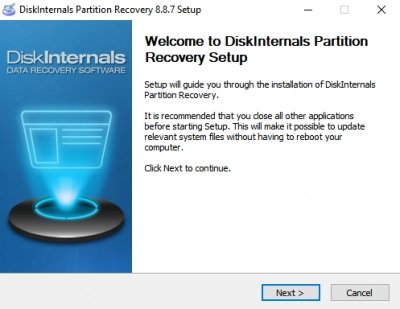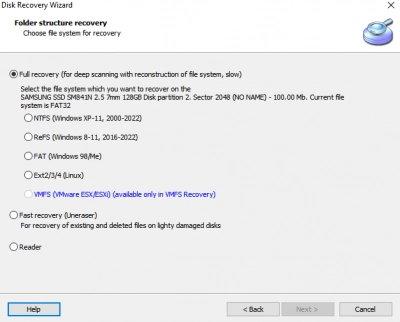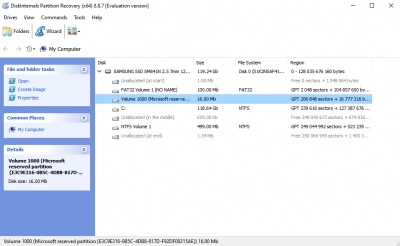How to Restore Deleted Partition in Windows?
Mistakenly deleting a partition that contains important files can be frustrating, but you’re not the only one it has happened to. Many people have mistakenly deleted their disk’s partition – even the bootable partition – and still restore partition (with the files intact) by using a Partition Recovery software.
Partition loss or data loss happens to everyone; even if you’re too careful not to delete the partitions yourself, the system may be attacked by a virus or malware, and you’d end up losing your files and partitions. Aside from malware and accidental deletion, OS crashes, power surges, software updates, and other scenarios/actions can lead to data/partition loss. How to restore partition?
The main thing is to have a reliable software tool you can fall back on when you need to restore partition. This article acts as a guide to restoring lost partitions on any hard drive using DiskInternals Partition Recovery to restore deleted partition.
What is the restore partition?
A restore partition, also known as a recovery partition, is a hidden partition on a hard drive that contains important files and tools that are used to restore a computer to its original factory state. The restore partition is typically created by the computer manufacturer and is used to recover the operating system, device drivers, and pre-installed software in case of a system failure or other issues.
The restore partition may contain a backup of the entire operating system, including system files, application software, and user data. This allows users to restore their system to a working state without the need for a separate backup or installation media.
To access the restore partition, users typically need to press a specific key or combination of keys during the computer's boot process. The exact key or combination of keys varies depending on the computer manufacturer and model.
To access the restore partition, users typically need to press a specific key or combination of keys during the computer's boot process. The exact key or combination of keys varies depending on the computer manufacturer and model.
Is it possible to restore a partition?
Yes, it is possible to restore a partition, but the success of the restoration depends on the reason for the partition loss and the actions taken after the partition was lost or damaged.
If the partition was lost due to accidental deletion or formatting, you may be able to recover the partition using data recovery software. There are many data recovery tools available, both free and paid, that can help you recover lost partitions and data. However, it is important to note that there is no guarantee that all data will be recovered, and some data may be permanently lost.
If the partition was lost due to hardware failure or other physical damage, such as a bad sector on the hard drive, data recovery software may not be able to restore the partition. In such cases, you may need to replace the damaged hardware or seek professional data recovery services.
To prevent data loss and ensure that partitions can be restored in case of an issue, it is recommended to create regular backups of important data and to keep a backup copy of the partition on an external drive or cloud storage. This way, if the partition is lost or damaged, you can easily restore it from the backup.
How to Restore Deleted Partition?
If you have accidentally deleted a partition and need to restore it, you can try the following steps:
Step 1: Select the Hard Disk with Deleted Partitions to restore partition
First, you have to download and install the DiskInternals Partition Recovery software. After the installation, launch the program and follow the Recovery Wizard, which will launch automatically.

Select the hard drive that contains the partition(s) you lost; DiskInternals Partition Recovery supports HDD, SSD, flash drive, external hard drive, memory cards, IDE disk, SATA disk, SCSI disk, etc.

DiskInternals Partition Recovery supports FAT, ReFS, UFS; HFS, NTFS, ReiserFS, APFS(reader mode), RomFS(reader mode); Reiser4, XFS, Ext2, Ext3, and Ext4 file system formats, making it one of the best Partition Recovery software tools for Windows OS (11, 10,8.1, 8, 7 and XP) computer users. Furthermore, the software lets you preview various file formats for free.
Step 2: Select Dive and “Scan” to dearch and restore partition
When you have selected the hard drive that contains the partition you lost, simply choose “Recovery Mode.” This software supports three recovery modes: Full Recovery, Fast Recovery, and Reader mode. If the partition has been long deleted, which means it may have been overwritten with new data, use the Full Recovery mode.

In Full scanning mode, DiskInternals Partition Recovery searches every part of your disk and recovers every data that has been lost from the drive. This mode also automatically repairs file structures and bypasses Windows security options to ensure that you recover the partition/data you seek.
Fast recovery mode is also efficient, but it may not discover all your lost partitions and files. It is advisable to use this mode only if you’re in haste and the files/partition you want to recover haven’t been lost for a long time.
Reader mode is used to access and open drives that won’t naturally open on Windows File Explorer (e.g., EXT drives from Linux systems or macOS disks).
Step 3: Preview and Restore Partitions
If you chose the Full Recovery mode, the scan might take a longer time to complete – you can cancel it at any time if you can’t wait longer, but it’s advisable to let it run completely before proceeding.
After the scan is complete, you will see all your lost partitions; you can open them to view the files saved inside. Other recovered files would be marked with red asterisks – so you can easily differentiate between lost/recovered files and existing documents on your drive.

The good thing is that DiskInternals Partition Recovery lets you preview virtually all recovered files for FREE. So, you can preview and confirm that you have recovered your files and partitions before proceeding to save them back to the system. To actually resave your lost partitions and files, you will need to buy the license.
Common Instances of Partition Recovery on Windows 10/11
In Windows operating systems, sometimes partitions can "disappear" for various reasons, even though they haven't been deleted. This can be distressing, especially if the partition contains important data. Here's a common scenario where a partition might seem to vanish, and steps you can take to possibly recover or restore visibility to that partition.
Situation 1: The Partition Likely Just Disappeared but Isn't Deleted
Causes:
- Drive letter missing or changed.
- The partition is hidden.
- Drive path is not assigned.
- File system corruption.
- Outdated or incompatible disk drivers.
1. Fix It Using Disk Management:
a. Press Windows + X and select Disk Management.
b. Look for the missing partition. If you see it listed (but perhaps without a drive letter), it hasn't been deleted.
c. If it's missing a drive letter, right-click on the partition and choose Change Drive Letter and Paths. Assign a new letter, and it should become visible in File Explorer.
d. If it’s showing as "Unallocated", this means the partition might have been deleted or corrupted.
2. Using Command Prompt:
a. Open Command Prompt as administrator.
b. Type diskpart and press Enter.
c. Type list disk and press Enter.
d. Identify the disk that had the missing partition and type select disk X (where X is the disk number).
e. Type list volume and see if the missing partition is listed.
f. If you find the missing partition, type select volume Y (where Y is the volume number of the missing partition).
g. Assign a letter by typing assign letter=Z (where Z is an available drive letter).
h. Exit diskpart and Command Prompt.
3. Checking for File System Corruption:
If the partition isn’t showing up due to file system corruption, you may need to run a check. Using Command Prompt as an administrator, type chkdsk X: /f (where X is the drive letter of the missing partition).
4. Update Disk Drivers:
Sometimes outdated or incompatible drivers might cause the partition to become invisible.
a. Press Windows + X and select Device Manager.
b. Expand “Disk drives”, right-click on the drive in question, and select Update driver.
5. Use Third-party Software:
If none of the above methods work, consider using third-party DiskInternals Partition Recovery tool. This program scan and recover partitions that have been accidentally deleted or have become invisible due to various reasons.Situation 2: Restorering of Specific Files from a Removed Windows Partition
If you've inadvertently removed a partition and need to restore specific files from that partition, it's a slightly more complex situation. However, the data might still be recoverable unless it's been overwritten. Here's a guide to potentially restore specific files from a deleted partition:
1. Cease Any Further Operations on the Disk:
- As soon as you realize a partition has been mistakenly deleted, stop all operations on the disk. The data from the deleted partition still remains on the disk until it gets overwritten by new data. The more you use the disk, the greater the risk of data overwrite.
2. Do Not Attempt to Re-create or Reformat the Partition:
- You might be tempted to recreate a partition in the unallocated space left by the deleted partition, but this can overwrite the data you're trying to recover.
3. Use Specialized Partition Recovery Software:
a. Install and launch DiskInternals Partition Recovery
b. Select the physical disk from which the partition was deleted.
c. Scan for lost or deleted partitions.
d. Once detected, the tool may allow you to explore the found partition and select specific files for recovery. e. Recover the selected files to a safe location (not on the same disk).
Situation 3: Recovering of Partition Table
If the partition table of a disk gets corrupted or deleted, the partitions on that disk may seem to disappear, even if the data remains intact on the drive. The partition table is a crucial component since it contains information about the size, type, and location of partitions on a disk.
Here's how to attempt recovery:
1. Use TestDisk:
TestDisk is a powerful, open-source software designed specifically to recover lost partitions and repair partition tables.
a. Download and launch TestDisk.
b. Choose to create a new log file.
c. Select the affected drive and choose the partition table type (usually "Intel").
d. Select “Analyze” to let TestDisk scan the disk for lost partitions.
e. If TestDisk finds your lost partitions, it will list them. You can then choose to write the corrected partition table.
f. Restart your computer.
2. Backup Before Any Recovery:
Before attempting any recovery, if you can, make an image backup of the entire drive. This is to ensure you can restore to the current state if something goes wrong during recovery. You can use tools like dd (on Linux) or software like Clonezilla to create an exact image of the drive.
3. Manual Recovery with a Hex Editor:
This is an advanced technique and should only be attempted by those familiar with disk structures and hex editing.
a. Use a hex editor that can access disk sectors (like HxD for Windows).
b. Manually search for partition headers or known file headers to identify partition starts.
c. Using the identified starts and known sizes (if available), manually reconstruct the partition table.
4. Preventive Measures for the Future:
a. Regular Backups: Always maintain backups of your important data and, if possible, a clone of your entire drive.
b. Avoid Unsafe Ejection: Always safely eject external drives. Abrupt removal can lead to data corruption.
c. Use UPS: If you're in an area prone to power outages, use an Uninterruptible Power Supply (UPS) to protect against sudden shutdowns which can lead to corruption.
d. Regular Check-ups: Occasionally run disk health checks and diagnostics to catch and fix errors before they become major issues.
Conclusion on how to restore partition
Partitions help segregate storage media, so you can store different file formats separately for easy access or specific reasons. Getting back deleted partitions is pretty easy and fast when you use an intuitive, professional software with up to 99 percent efficiency in partition recovery. So, partition loss isn’t something to throw you off balance; you can always get back everything and regain access to your important files.
FAQ
Can a deleted partition be recovered?
Partition loss or data loss happens to everyone; even if you’re too careful not to delete the partitions yourself, the system may be attacked by a virus or malware, and you’d end up losing your files and partitions. Aside from malware and accidental deletion, OS crashes, power surges, software updates, and other scenarios/actions can lead to data/partition loss.
So, the main thing is to have a reliable software tool you can fall back on when you get hit with such scenarios described above. This article acts as a guide to restore deleted partition on any hard drive using DiskInternals Partition Recovery.
How do I restore deleted partition in Windows 10?
Download and start DiskInternals Partition Recovery tool.
Step 1: Select the Hard Disk with Deleted Partitions
Step 2: Select Dive and “Scan” for Lost Partitions
Step 3: Preview and Restore Your Partitions
What does Recovering a partition do?
If you chose the Full Recovery mode, the scan might take a longer time to complete – you can cancel it at any time if you can’t wait longer, but it’s advisable to let it run completely before proceeding.
After the scan is complete, you will see all your lost partitions; you can open them to view the files saved inside. Other recovered files would be marked with red asterisks – so you can easily differentiate between lost/recovered files and existing documents on your drive.
The good thing is that DiskInternals Partition Recovery lets you preview virtually all recovered files for FREE. So, you can preview and confirm that you have recovered your files and partitions before proceeding to save them back to the system. To actually resave your lost partitions and files, you will need to buy the license.
How do I restore my original partition?
Restoring an original partition typically involves using a backup or recovery tool. If you have a backup of your original partition, you can use that to restore the partition.
Here are the general steps to restore your original partition using a backup or recovery tool:
1. Boot your computer from the recovery media (such as a recovery disc, USB drive, or a recovery partition) that you have created or obtained.
2. Select the option to restore your system or partition from a backup.
3. Choose the backup file or image that contains your original partition and follow the prompts to restore the partition.
If you do not have a backup of your original partition, you may still be able to recover some or all of the data using data recovery software. However, this process can be complex and may not be successful in all cases. It is always recommended to have a backup of your important data and partition to prevent data loss.
How do I reset a partition in Windows 10?
If you want to reset a partition in Windows 10, you can use the built-in Disk Management tool. Here are the steps:
- Press the Windows key + X and select "Disk Management" from the menu that appears.
- In the Disk Management window, locate the partition you want to reset. Right-click on it and select "Delete Volume".
- Confirm that you want to delete the volume by clicking "Yes".
- Once the partition is deleted, you should see unallocated space on the disk. Right-click on the unallocated space and select "New Simple Volume".
- Follow the prompts in the "New Simple Volume Wizard" to create a new partition. You can specify the partition size, drive letter, and file system format (such as NTFS or FAT32).
- Once the new partition is created, you can close Disk Management and use the partition as you wish.
Note that resetting a partition will delete all data on it, so be sure to back up any important files before proceeding.
Is it safe to delete Restore partition?
It is not safe to delete a Restore partition unless you have a complete backup of your system and are absolutely sure that you will not need to restore your system to its original state in the future. The Restore partition, also known as the Recovery partition, contains important files and tools that are used to restore your system to its original state in case of a system failure or other issues.
